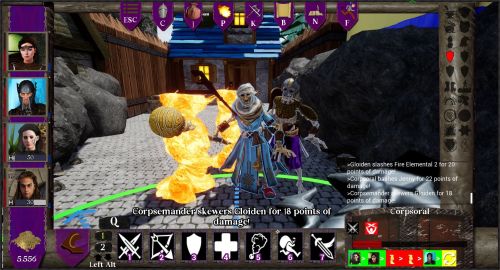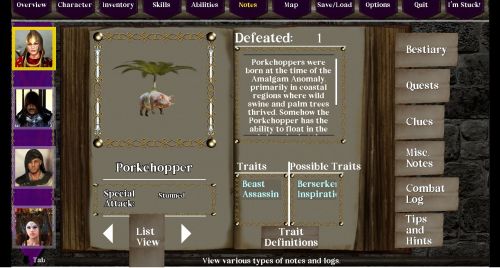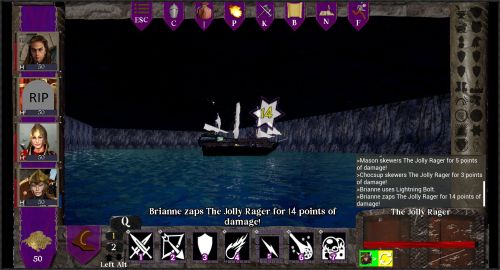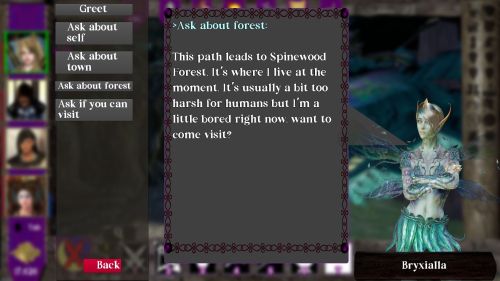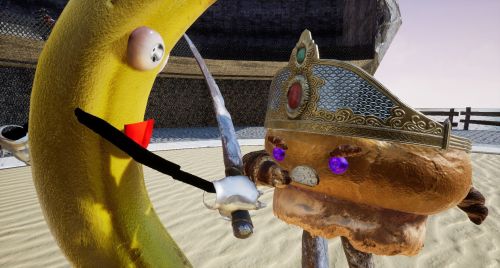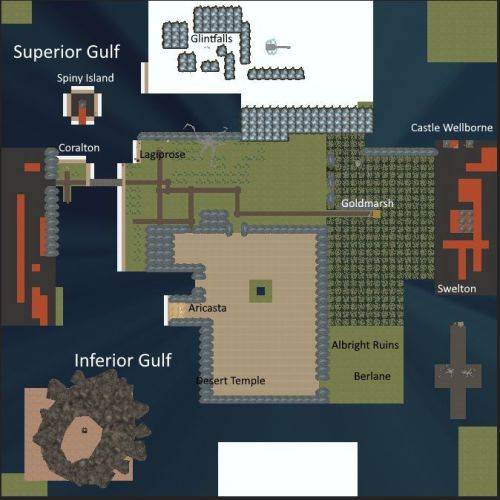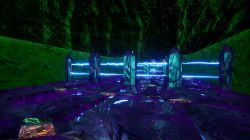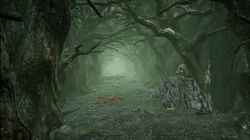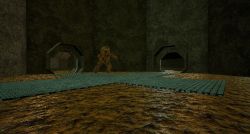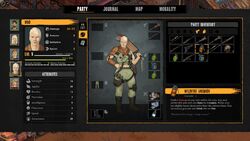RPG Codex Interview: Monsters of Mican
RPG Codex Interview: Monsters of Mican
Codex Interview - posted by Infinitron on Sat 8 June 2024, 20:35:23
Tags: Blankitt Productions; Monsters of Mican[Interview by JarlFrank]
1. What made you decide to develop Monsters of Mican and what influenced it? The Might & Magic influence is quite obvious, but what else went into it? Elsewhere, you told me that you started out with a bigger project, an open world like the classic M&M games, but then decided to do something smaller for your first game. Can you give us a short summary of the game's development journey?
I've always wanted to make a videogame, ever since I made my parents buy me a videogame development for dummies style book when I was like 10 or so. For the last 15 or so years I've been actively toying with it, from learning Blender to Adventure Game Studio to Unity and now Unreal. As I'm sure is a familiar story, I made plenty of prototypes and concepts but nothing ever actually came close to materializing.
One day I happened upon a site called LPArchive that had a number of great screenshot/text let's plays of some of my favorite older games, among them were the Quest for Glory series and Thuryl's excellent Might and Magic 1-5 series. As a kid I had loved M&M 7-8 specifically, and while I had given 3-5 a try a few times I never really experienced them fully until reading this LP. I started thinking about what went into making these games and realized that JVC managed to develop the first one on his own with only the tools available in the 80s, so surely I could make something like this on my own with the amazing game dev tools we have now, right?
So over the next few years I toyed around with M&M style projects, all with a specific backstory and world building in mind that I thought was both evocative of M&M but also unique and clever in its own right. I never really got the ball rolling until a few years ago when I found a great Unreal asset pack that helped teach me how to do turn based RPG combat, something I struggled with previously.
Obviously M&M was the major influence as you can tell, I wanted to include what I thought were the best aspects from the whole series. Quest for Glory was another big inspiration, specifically in the writing/humor and the way environmental interactions should make sense and provide various options. Dragon Quest is also another influence for this game in particular once it became clear while developing that the main focus would be on the monsters themselves.
As you said, I did plan at first to make this a full open game similar to M&M1-5. I made a whole world map and planned out 5 towns and 30ish dungeons, but found that my ambition way exceeded the scope of my abilities and decided to retain the core gameplay systems but completely start over with a new more condensed game structure. I plan to go back to the big open game in the future with the lessons I've learned developing this.
2. Monsters of Mican is very whimsical. Pretty much every piece of writing contains a joke and the majority of monsters are visual puns. What made you decide to go for this tone? Is it because funny monsters are easier to create with a limited budget? A lot of them feel cobbled together from various asset packs.
My writing style has always leaned heavily on humor and more particularly puns. I blame/cherish the QFG series for instilling that in me. Also as I noted above I was also using Dragon Quest for inspiration, which is also known for excellent monster puns.
Even if I had a larger budget and better modeling skills I think I would've used the same style of monster design. I have modeled a few from scratch before, and they'd all still wind up named Tyrannosaurus Specs (a dinosaur with glasses) or Raybee (a bee that shoots lasers from its stinger). A light, jovial tone is just something I've always appreciated in games that really resonate with me.
As for how these monsters were made, I would actually say that did more to inform the story of this game than it did the tone/sillyness. I started off under the presumption that most of the monsters I made would be placeholders until I could secure funding to contract artists, but I kept having so much fun combining and editing things that it made the story concept of the "amalgam anomaly" just click into place. I had always planned on there being an ancient event that brought all the monsters to the world but the way I designed this game is what really inspired me to write it in the way I did.
3. My favorite part of the game is its variety. Every dungeon level is different, with unique traps and puzzles and boss fights. How did you approach the level design for this game? Did you have any major inspirations to draw from (other RPGs, pen and paper modules, etc) or were most of your ideas original?
I approach game design as a player first, so I always look at what I've made and say "if I was playing the game would I enjoy this?" To that end one of my biggest gripes with RPGs specifically but a lot of games in general is the lack of meaningful variety in both combat and exploration. Sure, you can happen upon some aesthetically cool area in Skyrim like Blackreach but you'll still wind up traversing it the same way you would any other area. Or, in Breath of the Wild you'll see a new enemy but it's just a stronger reskin of the same thing you've been fighting over and over.
I wanted to make sure you never have that kind of feeling in my game. The variety needs to actually be meaningful- one level introduces collapsing floors, then the next powerful water currents, then lava fields and crushers. It serves both the effects of keeping the gameplay fresh and also actually reasonably reflecting the world/area you're supposed to be in. A mine can have collapsing floors, that makes sense. It probably won't have lava, and probably not pirate ships making waves. So save that for other levels!
Many of the actual features were my original ideas. Obviously a minecart ride is something that's been done (and I just wanted for the quick thrill of it) but that pirate ship idea, or freezing the water in the kraken lair, or giving the Zebrarian boss literal plot armor (made of books) were my original concepts.
4. Avoiding repetition is a worthy goal, and I feel like your dungeon design achieved that quite well. It's a great approach to level design especially in today's gaming world where procedural generation is being used more and more by both indies and larger companies - think of Skyrim's radiant quests and the flood of roguelikes and roguelites released nowadays. What do you think of this popularity of procedural generation among developers? Is level design becoming a lost art because of it? In my opinion, procedurally generated levels always feel the same, there's no variety because it's just an algorithm recombining the same elements over and over, unable to think outside of the box. Do you think we can fight back against this trend by developing games with excellent hand-made level design?
I tend to agree that procedural generation can be looked at as one of the root causes of games becoming stale and repetitive, but I don’t think it’s necessarily always the case or the only cause. Specifically for something like Skyrim, I believe the scope of the game is more to blame- you have hundreds upon hundreds of dungeons and NPCs and quests, and only a limited development team, so it is just a necessary fact of development that you’ll need to repeat certain themes, mechanics and elements. So in this instance I think the issue is more the scope of most bigger games from AAA publishers- the amount of content they think is necessary for consumers (rightly or wrongly, I can’t say for sure) drives the need for repetition.
That’s something that is mostly not an issue in the indie space. An exception as you mentioned is with roguelikes, and while I don’t necessarily agree that they always get repetitive (personally I think Binding of Isaac is one of my favorite indie games of all time) you can run into that trap. But here’s something I didn’t really understand fully until I started developing my own game:
Hand-made level design is hard!!! Like, really really hard!
Taking a completely blank slate and deciding on a theme, mechanics, gimmicks, and then eventually putting all the pieces together is an incredibly overwhelming and draining experience. It’s no wonder why procedural level generation is so popular, because it removes so many of the pitfalls and difficulties with this.
I’ve played with the idea of using procgen to come up with a base map, and then just editing that to match an idea in my mind, but even that can begin to feel repetitive and predictable for players, so I did wind up just making everything by hand, piece by piece, and I think I plan to do that for the next game too. Hopefully (for my sake) I can make a few custom tools that help make this process a bit faster to actually carry out, but mentally it is still quite draining trying to fill a blank slate like that.
5. In the dev diary/patch notes on Steam you announced some additional content for the game to be added for free in a future patch. What can we expect to see in this content patch? And do you plan to add more content in the future, or will that be all?
Right now the plan is for this to be the final content update. I'll still do bug fixes and other stability updates but the game will be complete after this update.
What you can expect in the new update is 5 new areas- 3 new dungeons accessible from town that are mainly geared towards offering stat upgrades for low-mid level parties, 1 new major dungeon towards the end of the game with expanded story content and a new boss or two, and the monster arena where you can bet on monster vs monster fights and watch them duke it out. Also sometime like 40-50 new monsters with some new traits, and either a harder NG+ mode or an extreme difficulty mode, I haven't yet decided which way to go. Maybe I'll wind up doing both.
I'm hoping for all of this content to be ready within a couple months, so far I'd say it's about 60-70% complete.
6. Speaking of the future, you mentioned Magic of Mican, a bigger open world game at the scale of M&M1-8. How far along is that sequel, and what are your plans for it now that you've gained some dev experience with the smaller Monsters of Mican?
I've mapped out a lot of the sequel already, and actually have something like 6 dungeons and 2 towns already made, but I do plan to go back and heavily revamp them after I'm done with this game. I've learned a ton about how to make development both smoother and lead to a better product, so I'll put those lessons to use for sure.
My experience marketing this game has also given me some new ideas into how to design the next one, with a need to focus more on individual characters. It's given me some neat ideas for the story structure.
7. What scale are you aiming for with the sequel? 6 dungeons and 2 towns sounds pretty sizeable already, if the dungeons are as large as the one in Monsters of Mican, but I assume they're a little smaller. Will there be different biomes (forests, deserts, glaciers, etc), and will the sci-fi elements return? I sure hope so because I love having spaceships on my fantasy worlds. Any plans for having choices & consequences? Branching storylines? Monsters of Mican already had two different endings based on who you decide to fight in the end.
I’ll give you a taste of what I have planned, and I’ll even attach a picture of the preliminary world map!
So far I’ve got 6 main towns planned, with a number of other buildings/settlements scattered throughout the world. They’ll mostly all have their own biomes, yes. Lagiprose is a typical grassland area, Swelton is in a volcanic region, Glintfalls is in the frozen tundra, Aricasta in the desert, etc. Each town has a few dungeons accessible in the town itself, and then others will be accessible from the world map. The dungeons I’ve made so far are actually quite a bit more elaborate than those in Monsters of Mican, which is one of the reasons I felt the need to scale back. I can’t say for sure if every dungeon in this game will be that complex but I hope they all at least have their own personalities.
My plan right now is to have the town regions all include both town buildings and NPCs, but also some surrounding wilderness, similar to how the maps in M&M 6-8 work. Then the world map is a tiled first person level that has you moving space by space at a certain rate (say, each step is 1/10th of a day), and you’ll encounter enemies, tents, buildings, dungeons, loot on the world map just like you would in the town maps.
The game structure will be totally different from Monsters of Mican. It will be much more open and nonlinear, though pretty heavily guided in the beginning section. For instance, after you first exit the starting town Lagiprose (turn that around and remove the E for a fun easter egg), you will find yourself surrounded on one side by thick forest, another by mountains, and another by water, so you will only be able to move one way… until you learn skill ranks or abilities that help you navigate thick forests, mountains and water. This is more or less how it worked in the M&M1-5 games.
The main game structure will revolve around finding, gaining access to, and then doing something with 4 big mcguffins. I won’t reveal exactly what that something is yet, but it is very closely related to what you mentioned with the sci-fi elements and spaceships. As I said I’ve built some deep backstory and world building in the decade or so that I’ve been toying around with this game idea.
There will be a final choice similar to Monsters of Mican, though I can’t say for sure yet if there are going to be two different final bosses again.
Here are some sneak peek shots of the sequel, still work in progress of course:
8. The classic dungeon crawler genre is a small but lively niche. How familiar are you with other indie games in the genre? As a developer who finished and released a dungeon crawler, is there any advice you would give to other indies? Anything in your development process you thought worked particularly well, or any dead ends you hit during development you wished you could have avoided?
I've only really played the well known games, like the Grimlocks and the Quest. I do plan to branch out a bit more once I've given myself a bit more time to game- I've been eyeing the Amberland games in particular.
As for advice, I guess I'll say the main thing is to know your strengths and weaknesses, and don't try to force yourself to do things you aren't great at. I've never been great at modeling so I decided to just edit and combine existing meshes rather than brute force something I knew would be poor in quality. And let your mechanics and your development process inform your story! A lot of people want to make a game by writing a story first and then trying to fit the game around that story, but I find it is far more effective to learn what kind of game you are actually able to develop before assigning yourself a rigid story/setting to work with. Be flexible at first!
9. I can quite recommend the Amberlands, they're very good M&M3-5 style games. Speaking of other games in the genre, and since you played the Grimrocks, where do you think the dungeon crawler genre will be in the next couple of years? Any trends you're anticipating? And why do you think it was the real-time Dungeon Master/Eye of the Beholder style that revived the classic dungeon crawler, rather than the turn-based Wizardry/Might & Magic style? When Grimrock released, it breathed new life into the genre and inspired a lot of clones, but only recently have we seen more M&M/Wiz style games.
I don’t really have good answers for this! I’ll agree that it was likely Grimlock that sorta opened the floodgates for the genre to have a resurgence, but I have no idea why turn-based games weren’t coming back so much until now. Maybe Baldur’s Gate 3 kind of brought back the entire turn-based RPG into the public consciousness, showing how fun and innovative it can be? I love it anyhow, since I much prefer turn based RPGs to action.
10. You initially released Monsters of Mican only on the Epic Store, which has a rather bad reputation among gamers. Later, you branched out to Steam and itch.io. What were your experiences with these different storefronts? And why did you go for Epic first, when Steam is generally considered to reach a wider audience, especially for niche games, whereas Epic is only used by Fortnite kiddies?
Rather coincidentally, I was finishing up development on the game at around the same time Epic was beginning to offer a new program they called Epic First Run. This program offered the developer 100% of the revenue and (more importantly for me) preferential placement/marketing in exchange for 6 months of PC exclusivity.
I had zero experience with marketing, and very little knowledge of the ins and outs of the (modern) PC gaming community, so when I saw that they'd offer preferential store placement I decided that this boost in visibility would help jump start the marketing for the game. I was absolutely unaware of the reputation EGS has at the time, I just knew they offered good deals to developers which seemed beneficial to a first time solo dev.
If I was going to do it again I would absolutely release on Steam simultaneously, but in the end it all worked out as I was able to give the game a major (sorely needed) UI face lift before the steam launch, as well as another burst of momentum.
11. I hope it's not too personal a question, but could you tell us how the game performed commercially? Devs tend to be shy about revealing that information, but I'm curious whether it met your expectations or even exceeded them. You said that you had zero experience with marketing before this. How did you approach marketing the game? Where did you advertise it, and how did you try finding an audience? I discovered it through a Steam curator (Wizard Worm RPGs Universe), then wrote a review myself and recommended it through my own curator... word of mouth is the best marketing for games like this, but first people have to find out it exists in the first place.
I’d be lying if I said I had no hopes that the game would take off, but when it comes to actual grounded expectations, I really had no idea what to expect. I am not well versed in the PC gaming space or Steam in particular, and this is my first foray into the dev side of the indie dev world, so I really had no idea what kind of performance to expect. So far the game has actually done reasonably well for how I marketed it, getting into triple digit sales within the first couple months. I do hope that it can grow over time as word of mouth spreads since I’ve seen a number of extremely positive reviews even besides the review you wrote. (As an aside, seeing these glowing reviews TBH means more to me than the actual game sales- I am beyond thrilled any time someone enjoys the game!)
As for marketing, my first mistake was in not marketing the game before release. As I said, I’m very new to this so I did not realize that marketing usually starts months/years before launch. It would have helped me immensely to put up a Steam page and maybe a demo ~6 months before launch to help build up wishlists and get the game’s name out there. But, what can you do, I’m trying to make do with the situation the best I can.
Wizard Worm was an excellent recommendation sent to me by someone on the Dungeon Crawler discord server, I have noticed a lot of people look at his channels for game recommendations. Other than that I’ve used Keymailer to try and send some keys to content creators/influencers, with some success. I’ve also emailed/submitted to a number of bigger publications, but those tend to fairly frequently overlook indies that aren’t already somewhat well known. As I’m sure many are aware it is not easy at all to break out as an unknown indie.
Mainly I’m trying to continue supporting the game and community on Steam, Twitter and Keymailer, but I don’t plan to spend too much money on marketing for this game. I think for the next one I may try to invest a bit more.
12. Final question of the interview: What do you think is the most important part of a game? Is it the core gameplay mechanics? Is it the level and encounter design (including puzzles etc)? Is is the story? Curious to know how you weigh these elements.
For me I will say it’s the core gameplay mechanics, and more specifically as part of those mechanics, it is character growth and progression. Years ago on Famiboards I randomly decided to do a writeup on why I have such a fondness for the Might and Magic series, and I realized it’s the sense of progression you get in those games. Especially 6-8, when gaining a skill rank by finding a teacher somewhere in the world immediately gives you major combat/exploration upgrades. I think nailing that “instantly noticeable upgrade” feeling as a reward for both combat and exploration is the key to making a good, satisfying RPG.
Things like story, level design, even monster design (which I love now, see my “Making a Monster” series on my youtube channel) always took a backseat to gameplay and progression for me as a player. So that was the first thing I wanted to nail down when designing this game, the idea that you will see many instant and noticeable upgrades throughout the game. [What I mean by “instant” here if it’s not clear is that the upgrade will change your abilities drastically- like with the bow skill for instance, going from Expert Bow to Master Bow not only increases the skill damage bonus from 2x to 3x, but it also fires an extra arrow with each shot, effectively making that a 6x bonus. Or any of the various magic skills that let you learn a whole new set of spells after moving to the next rank.]
1. What made you decide to develop Monsters of Mican and what influenced it? The Might & Magic influence is quite obvious, but what else went into it? Elsewhere, you told me that you started out with a bigger project, an open world like the classic M&M games, but then decided to do something smaller for your first game. Can you give us a short summary of the game's development journey?
I've always wanted to make a videogame, ever since I made my parents buy me a videogame development for dummies style book when I was like 10 or so. For the last 15 or so years I've been actively toying with it, from learning Blender to Adventure Game Studio to Unity and now Unreal. As I'm sure is a familiar story, I made plenty of prototypes and concepts but nothing ever actually came close to materializing.
One day I happened upon a site called LPArchive that had a number of great screenshot/text let's plays of some of my favorite older games, among them were the Quest for Glory series and Thuryl's excellent Might and Magic 1-5 series. As a kid I had loved M&M 7-8 specifically, and while I had given 3-5 a try a few times I never really experienced them fully until reading this LP. I started thinking about what went into making these games and realized that JVC managed to develop the first one on his own with only the tools available in the 80s, so surely I could make something like this on my own with the amazing game dev tools we have now, right?
So over the next few years I toyed around with M&M style projects, all with a specific backstory and world building in mind that I thought was both evocative of M&M but also unique and clever in its own right. I never really got the ball rolling until a few years ago when I found a great Unreal asset pack that helped teach me how to do turn based RPG combat, something I struggled with previously.
Obviously M&M was the major influence as you can tell, I wanted to include what I thought were the best aspects from the whole series. Quest for Glory was another big inspiration, specifically in the writing/humor and the way environmental interactions should make sense and provide various options. Dragon Quest is also another influence for this game in particular once it became clear while developing that the main focus would be on the monsters themselves.
As you said, I did plan at first to make this a full open game similar to M&M1-5. I made a whole world map and planned out 5 towns and 30ish dungeons, but found that my ambition way exceeded the scope of my abilities and decided to retain the core gameplay systems but completely start over with a new more condensed game structure. I plan to go back to the big open game in the future with the lessons I've learned developing this.
2. Monsters of Mican is very whimsical. Pretty much every piece of writing contains a joke and the majority of monsters are visual puns. What made you decide to go for this tone? Is it because funny monsters are easier to create with a limited budget? A lot of them feel cobbled together from various asset packs.
My writing style has always leaned heavily on humor and more particularly puns. I blame/cherish the QFG series for instilling that in me. Also as I noted above I was also using Dragon Quest for inspiration, which is also known for excellent monster puns.
Even if I had a larger budget and better modeling skills I think I would've used the same style of monster design. I have modeled a few from scratch before, and they'd all still wind up named Tyrannosaurus Specs (a dinosaur with glasses) or Raybee (a bee that shoots lasers from its stinger). A light, jovial tone is just something I've always appreciated in games that really resonate with me.
As for how these monsters were made, I would actually say that did more to inform the story of this game than it did the tone/sillyness. I started off under the presumption that most of the monsters I made would be placeholders until I could secure funding to contract artists, but I kept having so much fun combining and editing things that it made the story concept of the "amalgam anomaly" just click into place. I had always planned on there being an ancient event that brought all the monsters to the world but the way I designed this game is what really inspired me to write it in the way I did.
3. My favorite part of the game is its variety. Every dungeon level is different, with unique traps and puzzles and boss fights. How did you approach the level design for this game? Did you have any major inspirations to draw from (other RPGs, pen and paper modules, etc) or were most of your ideas original?
I approach game design as a player first, so I always look at what I've made and say "if I was playing the game would I enjoy this?" To that end one of my biggest gripes with RPGs specifically but a lot of games in general is the lack of meaningful variety in both combat and exploration. Sure, you can happen upon some aesthetically cool area in Skyrim like Blackreach but you'll still wind up traversing it the same way you would any other area. Or, in Breath of the Wild you'll see a new enemy but it's just a stronger reskin of the same thing you've been fighting over and over.
I wanted to make sure you never have that kind of feeling in my game. The variety needs to actually be meaningful- one level introduces collapsing floors, then the next powerful water currents, then lava fields and crushers. It serves both the effects of keeping the gameplay fresh and also actually reasonably reflecting the world/area you're supposed to be in. A mine can have collapsing floors, that makes sense. It probably won't have lava, and probably not pirate ships making waves. So save that for other levels!
Many of the actual features were my original ideas. Obviously a minecart ride is something that's been done (and I just wanted for the quick thrill of it) but that pirate ship idea, or freezing the water in the kraken lair, or giving the Zebrarian boss literal plot armor (made of books) were my original concepts.
4. Avoiding repetition is a worthy goal, and I feel like your dungeon design achieved that quite well. It's a great approach to level design especially in today's gaming world where procedural generation is being used more and more by both indies and larger companies - think of Skyrim's radiant quests and the flood of roguelikes and roguelites released nowadays. What do you think of this popularity of procedural generation among developers? Is level design becoming a lost art because of it? In my opinion, procedurally generated levels always feel the same, there's no variety because it's just an algorithm recombining the same elements over and over, unable to think outside of the box. Do you think we can fight back against this trend by developing games with excellent hand-made level design?
I tend to agree that procedural generation can be looked at as one of the root causes of games becoming stale and repetitive, but I don’t think it’s necessarily always the case or the only cause. Specifically for something like Skyrim, I believe the scope of the game is more to blame- you have hundreds upon hundreds of dungeons and NPCs and quests, and only a limited development team, so it is just a necessary fact of development that you’ll need to repeat certain themes, mechanics and elements. So in this instance I think the issue is more the scope of most bigger games from AAA publishers- the amount of content they think is necessary for consumers (rightly or wrongly, I can’t say for sure) drives the need for repetition.
That’s something that is mostly not an issue in the indie space. An exception as you mentioned is with roguelikes, and while I don’t necessarily agree that they always get repetitive (personally I think Binding of Isaac is one of my favorite indie games of all time) you can run into that trap. But here’s something I didn’t really understand fully until I started developing my own game:
Hand-made level design is hard!!! Like, really really hard!
Taking a completely blank slate and deciding on a theme, mechanics, gimmicks, and then eventually putting all the pieces together is an incredibly overwhelming and draining experience. It’s no wonder why procedural level generation is so popular, because it removes so many of the pitfalls and difficulties with this.
I’ve played with the idea of using procgen to come up with a base map, and then just editing that to match an idea in my mind, but even that can begin to feel repetitive and predictable for players, so I did wind up just making everything by hand, piece by piece, and I think I plan to do that for the next game too. Hopefully (for my sake) I can make a few custom tools that help make this process a bit faster to actually carry out, but mentally it is still quite draining trying to fill a blank slate like that.
5. In the dev diary/patch notes on Steam you announced some additional content for the game to be added for free in a future patch. What can we expect to see in this content patch? And do you plan to add more content in the future, or will that be all?
Right now the plan is for this to be the final content update. I'll still do bug fixes and other stability updates but the game will be complete after this update.
What you can expect in the new update is 5 new areas- 3 new dungeons accessible from town that are mainly geared towards offering stat upgrades for low-mid level parties, 1 new major dungeon towards the end of the game with expanded story content and a new boss or two, and the monster arena where you can bet on monster vs monster fights and watch them duke it out. Also sometime like 40-50 new monsters with some new traits, and either a harder NG+ mode or an extreme difficulty mode, I haven't yet decided which way to go. Maybe I'll wind up doing both.
I'm hoping for all of this content to be ready within a couple months, so far I'd say it's about 60-70% complete.
6. Speaking of the future, you mentioned Magic of Mican, a bigger open world game at the scale of M&M1-8. How far along is that sequel, and what are your plans for it now that you've gained some dev experience with the smaller Monsters of Mican?
I've mapped out a lot of the sequel already, and actually have something like 6 dungeons and 2 towns already made, but I do plan to go back and heavily revamp them after I'm done with this game. I've learned a ton about how to make development both smoother and lead to a better product, so I'll put those lessons to use for sure.
My experience marketing this game has also given me some new ideas into how to design the next one, with a need to focus more on individual characters. It's given me some neat ideas for the story structure.
7. What scale are you aiming for with the sequel? 6 dungeons and 2 towns sounds pretty sizeable already, if the dungeons are as large as the one in Monsters of Mican, but I assume they're a little smaller. Will there be different biomes (forests, deserts, glaciers, etc), and will the sci-fi elements return? I sure hope so because I love having spaceships on my fantasy worlds. Any plans for having choices & consequences? Branching storylines? Monsters of Mican already had two different endings based on who you decide to fight in the end.
I’ll give you a taste of what I have planned, and I’ll even attach a picture of the preliminary world map!
So far I’ve got 6 main towns planned, with a number of other buildings/settlements scattered throughout the world. They’ll mostly all have their own biomes, yes. Lagiprose is a typical grassland area, Swelton is in a volcanic region, Glintfalls is in the frozen tundra, Aricasta in the desert, etc. Each town has a few dungeons accessible in the town itself, and then others will be accessible from the world map. The dungeons I’ve made so far are actually quite a bit more elaborate than those in Monsters of Mican, which is one of the reasons I felt the need to scale back. I can’t say for sure if every dungeon in this game will be that complex but I hope they all at least have their own personalities.
My plan right now is to have the town regions all include both town buildings and NPCs, but also some surrounding wilderness, similar to how the maps in M&M 6-8 work. Then the world map is a tiled first person level that has you moving space by space at a certain rate (say, each step is 1/10th of a day), and you’ll encounter enemies, tents, buildings, dungeons, loot on the world map just like you would in the town maps.
The game structure will be totally different from Monsters of Mican. It will be much more open and nonlinear, though pretty heavily guided in the beginning section. For instance, after you first exit the starting town Lagiprose (turn that around and remove the E for a fun easter egg), you will find yourself surrounded on one side by thick forest, another by mountains, and another by water, so you will only be able to move one way… until you learn skill ranks or abilities that help you navigate thick forests, mountains and water. This is more or less how it worked in the M&M1-5 games.
The main game structure will revolve around finding, gaining access to, and then doing something with 4 big mcguffins. I won’t reveal exactly what that something is yet, but it is very closely related to what you mentioned with the sci-fi elements and spaceships. As I said I’ve built some deep backstory and world building in the decade or so that I’ve been toying around with this game idea.
There will be a final choice similar to Monsters of Mican, though I can’t say for sure yet if there are going to be two different final bosses again.
Here are some sneak peek shots of the sequel, still work in progress of course:
8. The classic dungeon crawler genre is a small but lively niche. How familiar are you with other indie games in the genre? As a developer who finished and released a dungeon crawler, is there any advice you would give to other indies? Anything in your development process you thought worked particularly well, or any dead ends you hit during development you wished you could have avoided?
I've only really played the well known games, like the Grimlocks and the Quest. I do plan to branch out a bit more once I've given myself a bit more time to game- I've been eyeing the Amberland games in particular.
As for advice, I guess I'll say the main thing is to know your strengths and weaknesses, and don't try to force yourself to do things you aren't great at. I've never been great at modeling so I decided to just edit and combine existing meshes rather than brute force something I knew would be poor in quality. And let your mechanics and your development process inform your story! A lot of people want to make a game by writing a story first and then trying to fit the game around that story, but I find it is far more effective to learn what kind of game you are actually able to develop before assigning yourself a rigid story/setting to work with. Be flexible at first!
9. I can quite recommend the Amberlands, they're very good M&M3-5 style games. Speaking of other games in the genre, and since you played the Grimrocks, where do you think the dungeon crawler genre will be in the next couple of years? Any trends you're anticipating? And why do you think it was the real-time Dungeon Master/Eye of the Beholder style that revived the classic dungeon crawler, rather than the turn-based Wizardry/Might & Magic style? When Grimrock released, it breathed new life into the genre and inspired a lot of clones, but only recently have we seen more M&M/Wiz style games.
I don’t really have good answers for this! I’ll agree that it was likely Grimlock that sorta opened the floodgates for the genre to have a resurgence, but I have no idea why turn-based games weren’t coming back so much until now. Maybe Baldur’s Gate 3 kind of brought back the entire turn-based RPG into the public consciousness, showing how fun and innovative it can be? I love it anyhow, since I much prefer turn based RPGs to action.
10. You initially released Monsters of Mican only on the Epic Store, which has a rather bad reputation among gamers. Later, you branched out to Steam and itch.io. What were your experiences with these different storefronts? And why did you go for Epic first, when Steam is generally considered to reach a wider audience, especially for niche games, whereas Epic is only used by Fortnite kiddies?
Rather coincidentally, I was finishing up development on the game at around the same time Epic was beginning to offer a new program they called Epic First Run. This program offered the developer 100% of the revenue and (more importantly for me) preferential placement/marketing in exchange for 6 months of PC exclusivity.
I had zero experience with marketing, and very little knowledge of the ins and outs of the (modern) PC gaming community, so when I saw that they'd offer preferential store placement I decided that this boost in visibility would help jump start the marketing for the game. I was absolutely unaware of the reputation EGS has at the time, I just knew they offered good deals to developers which seemed beneficial to a first time solo dev.
If I was going to do it again I would absolutely release on Steam simultaneously, but in the end it all worked out as I was able to give the game a major (sorely needed) UI face lift before the steam launch, as well as another burst of momentum.
11. I hope it's not too personal a question, but could you tell us how the game performed commercially? Devs tend to be shy about revealing that information, but I'm curious whether it met your expectations or even exceeded them. You said that you had zero experience with marketing before this. How did you approach marketing the game? Where did you advertise it, and how did you try finding an audience? I discovered it through a Steam curator (Wizard Worm RPGs Universe), then wrote a review myself and recommended it through my own curator... word of mouth is the best marketing for games like this, but first people have to find out it exists in the first place.
I’d be lying if I said I had no hopes that the game would take off, but when it comes to actual grounded expectations, I really had no idea what to expect. I am not well versed in the PC gaming space or Steam in particular, and this is my first foray into the dev side of the indie dev world, so I really had no idea what kind of performance to expect. So far the game has actually done reasonably well for how I marketed it, getting into triple digit sales within the first couple months. I do hope that it can grow over time as word of mouth spreads since I’ve seen a number of extremely positive reviews even besides the review you wrote. (As an aside, seeing these glowing reviews TBH means more to me than the actual game sales- I am beyond thrilled any time someone enjoys the game!)
As for marketing, my first mistake was in not marketing the game before release. As I said, I’m very new to this so I did not realize that marketing usually starts months/years before launch. It would have helped me immensely to put up a Steam page and maybe a demo ~6 months before launch to help build up wishlists and get the game’s name out there. But, what can you do, I’m trying to make do with the situation the best I can.
Wizard Worm was an excellent recommendation sent to me by someone on the Dungeon Crawler discord server, I have noticed a lot of people look at his channels for game recommendations. Other than that I’ve used Keymailer to try and send some keys to content creators/influencers, with some success. I’ve also emailed/submitted to a number of bigger publications, but those tend to fairly frequently overlook indies that aren’t already somewhat well known. As I’m sure many are aware it is not easy at all to break out as an unknown indie.
Mainly I’m trying to continue supporting the game and community on Steam, Twitter and Keymailer, but I don’t plan to spend too much money on marketing for this game. I think for the next one I may try to invest a bit more.
12. Final question of the interview: What do you think is the most important part of a game? Is it the core gameplay mechanics? Is it the level and encounter design (including puzzles etc)? Is is the story? Curious to know how you weigh these elements.
For me I will say it’s the core gameplay mechanics, and more specifically as part of those mechanics, it is character growth and progression. Years ago on Famiboards I randomly decided to do a writeup on why I have such a fondness for the Might and Magic series, and I realized it’s the sense of progression you get in those games. Especially 6-8, when gaining a skill rank by finding a teacher somewhere in the world immediately gives you major combat/exploration upgrades. I think nailing that “instantly noticeable upgrade” feeling as a reward for both combat and exploration is the key to making a good, satisfying RPG.
Things like story, level design, even monster design (which I love now, see my “Making a Monster” series on my youtube channel) always took a backseat to gameplay and progression for me as a player. So that was the first thing I wanted to nail down when designing this game, the idea that you will see many instant and noticeable upgrades throughout the game. [What I mean by “instant” here if it’s not clear is that the upgrade will change your abilities drastically- like with the bow skill for instance, going from Expert Bow to Master Bow not only increases the skill damage bonus from 2x to 3x, but it also fires an extra arrow with each shot, effectively making that a 6x bonus. Or any of the various magic skills that let you learn a whole new set of spells after moving to the next rank.]
There are 21 comments on RPG Codex Interview: Monsters of Mican





